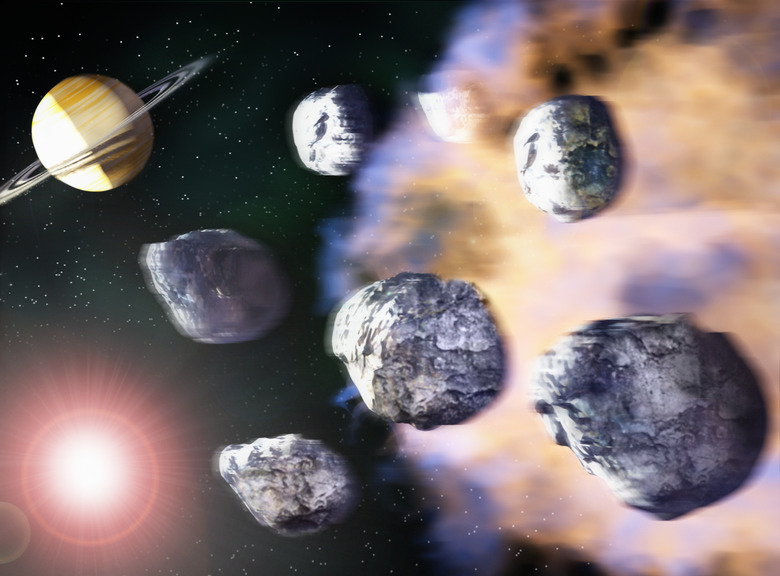How To Make A Model Of The Asteroid Belt
The solar system is one of the more fascinating areas of study in elementary school, as the young students enjoy learning about the planets around them, gaining for the first time a sense of the sheer scale of the universe — and even pondering which planets might hold alien life. The Asteroid Belt contains smaller bodies revolving around the Sun between the orbits of Mars and Jupiter. While it might be beyond our current capacity to give students a tour of the belt, helping them build a model of it can facilitate understanding of the whole solar system.
Step 1
Draw the Sun, either in the center of the paper or at the left or right edge. Outline it and color it yellow.
Step 2
Add in the orbits of the planets, and draw each planet on its orbit, giving each planet its own color. If the Sun is in the center, you'll have concentric orbits. If the Sun is on one edge, you'll have the orbits as semicircles (or half ovals). While it's impossible to represent the true scale of the orbits on a sheet of butcher paper and be able to see the inner planets, you can express the relative distances of each planet from the Sun. There are several websites where you can calculate the relative distances, based on the size of your model (see Resources). For example, if you give a 20-inch distance between the Sun and Mercury, then it would be approximately 18.8 more inches to Venus, about 15 more inches to Earth, about 28 more inches to Mars, and then (to scale) about 17 more FEET to Jupiter. The Asteroid Belt would go in between Mars and Jupiter, starting about 48 inches past Mars and going about four feet out. The shorter your distance between the Sun and Mercury, the shorter the other distances would be as well, proportionally.
Step 3
Draw a circle to begin creating your asteroids in the space assigned to the belt. There is a lot of space in the Asteroid Belt, so you don't want to draw a round wall of rock. Instead, space them out and make them larger than life so that you can show your viewer what an asteroid looks like.
Step 4
Draw two lines to form an "X" inside the circle. In drawing, these are called "guide lines." The "X" should cross near the center of the circle — but not exactly on it, as few asteroids, if any, are perfectly symmetrical. The angles at the center of the "X," though, should all be 90 degrees, or right angles.
Step 5
Outline your craters on the asteroid. These can look like clouds, potatoes or gerbils, depending on your imagination (don't add whiskers and legs, though). Draw four or five of these on your circle.
Step 6
Add some smaller circles and lumps to the surface of your circle to show the bumpy surface. Add some shading lines inside some of your crater shapes to give the illusion of depth.
Step 7
Erase your guide lines and color in your asteroid. Generally, asteroids range in color from a dark orange to brown to a dark gray. Repeat Steps 3 through 7 for each asteroid.
Things Needed
- Butcher paper
- Black marker
- Other colored markers (including orange, brown and gray)
Cite This Article
MLA
Renico, Leslie. "How To Make A Model Of The Asteroid Belt" sciencing.com, https://www.sciencing.com/make-model-asteroid-belt-10030864/. 21 July 2017.
APA
Renico, Leslie. (2017, July 21). How To Make A Model Of The Asteroid Belt. sciencing.com. Retrieved from https://www.sciencing.com/make-model-asteroid-belt-10030864/
Chicago
Renico, Leslie. How To Make A Model Of The Asteroid Belt last modified March 24, 2022. https://www.sciencing.com/make-model-asteroid-belt-10030864/
